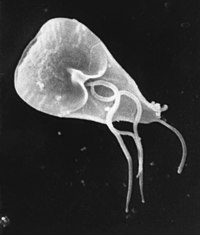
Photo from wikipedia
The spatial heterogeneity of carrier dynamics in polycrystalline metal halide perovskite (MHP) thin films has a strong influence on photovoltaic device performance; however, the underlying cause is not yet clearly… Click to show full abstract
The spatial heterogeneity of carrier dynamics in polycrystalline metal halide perovskite (MHP) thin films has a strong influence on photovoltaic device performance; however, the underlying cause is not yet clearly understood. Here, the sub‐micrometer scale mapping of charge carrier dynamics in CH3NH3PbI3 thin films using time‐resolved nonlinear optical microscopy, specifically transient absorption microscopy (TAM) with sub‐picosecond (ps) and time‐resolved photoluminescence (PL) microscopy with nanosecond temporal resolution is reported. To study the influence of physical morphology on charge carrier dynamics, MHP thin films having granular‐ and fibrous structures are investigated. On both types of films, spatial regions with short‐lived transient gain signals (fast nonradiative relaxation within ≈1 ps) typically show slower charge recombination via radiative relaxation, which is attributed to the presence of additional energy states near the band edge. In addition, fibrous films show longer PL lifetimes. Interestingly, the functional contrast shown in TAM images exhibits fundamental differences from the structural contrast shown in scanning electron microscopy images, implying that the variation of trap density in the bulk contributes to the observed spatial heterogeneity in carrier dynamics.
Journal Title: Advanced Optical Materials
Year Published: 2019
Link to full text (if available)
Share on Social Media: Sign Up to like & get
recommendations!